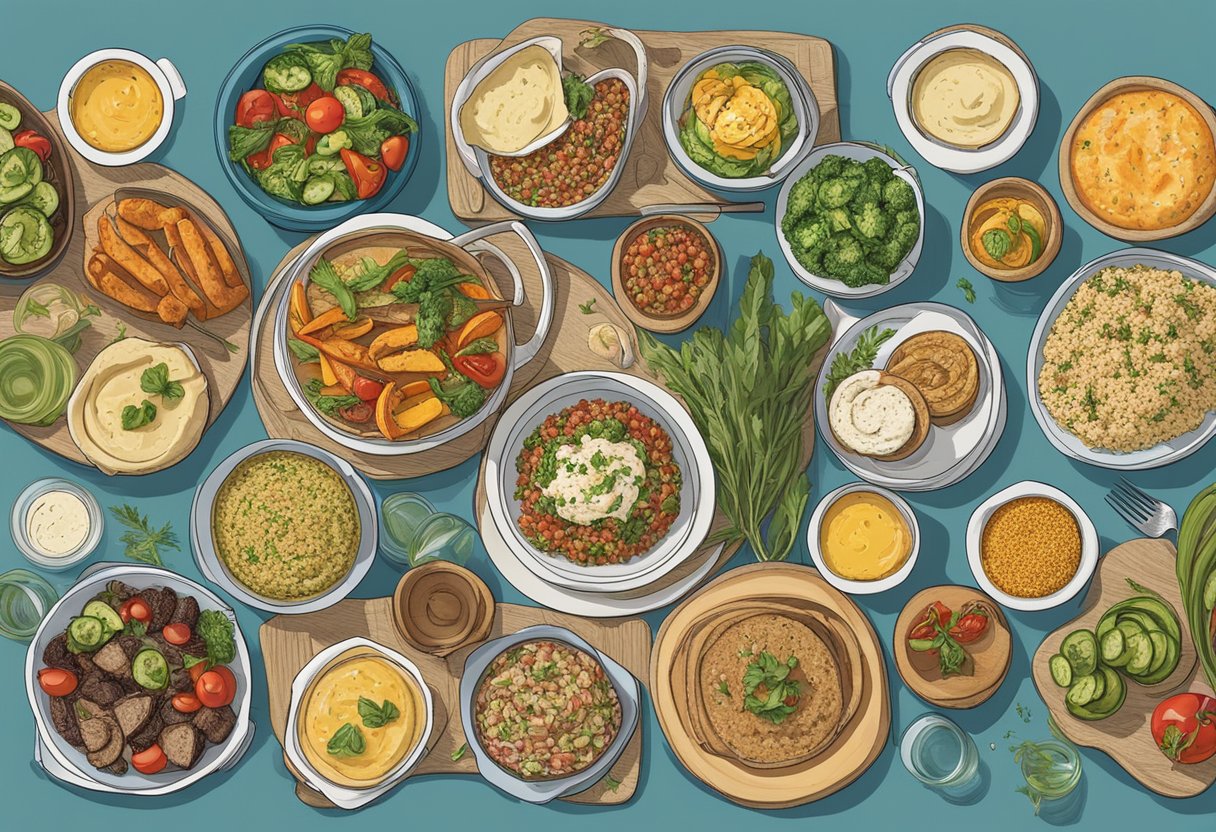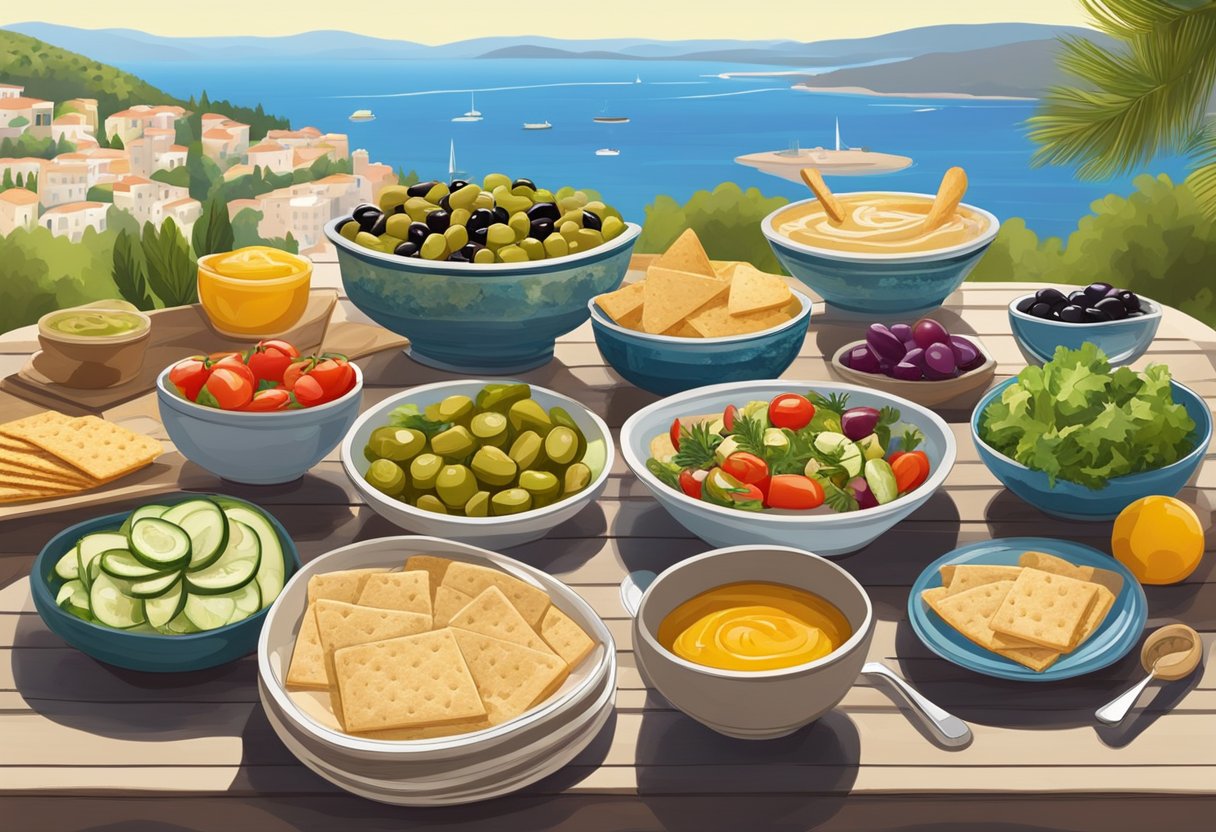Eating out on a gluten-free Mediterranean diet combines the heart-healthy principles of the traditional Mediterranean diet with the necessary restrictions of a gluten-free lifestyle. It emphasizes consuming a diverse array of fruits, vegetables, nuts, legumes, fish, and oils, while avoiding gluten-containing grains that are harmful for those with celiac disease or gluten sensitivity. When dining at restaurants, individuals following this dietary approach need to carefully select dishes that align with the Mediterranean principles and ensure that foods are truly gluten-free, a challenge that can often be managed through clear communication with the restaurant staff and careful menu selection.

The gluten-free Mediterranean diet calls for creativity and vigilance in avoiding gluten, which is found in wheat, barley, and rye. When eating out, the focus should be on whole foods that are naturally gluten-free and central to the Mediterranean diet, while steering clear of cross-contamination with gluten-containing items. It is important to be aware of hidden sources of gluten in sauces and dressings and to opt for establishments that understand or specialize in gluten-free cooking methods. By adapting traditional Mediterranean dishes to avoid gluten, and choosing restaurants that cater to these dietary needs, patrons can enjoy a wide range of healthy, satisfying meals.
Key Takeaways
- A gluten-free Mediterranean diet focuses on heart-healthy, naturally gluten-free foods while avoiding cross-contamination.
- Communication with the restaurant staff is essential to ensure meals adhere to both Mediterranean and gluten-free guidelines.
- The diet encourages adapting Mediterranean dishes to be gluten-free, seeking establishments with gluten-free options.
Table of Contents
Understanding the Gluten-Free Mediterranean Diet

Adopting a gluten-free Mediterranean diet involves embracing the nutritious bounty of the Mediterranean region while meticulously avoiding gluten, a protein complex found in wheat, barley, and rye which can trigger adverse reactions for individuals with celiac disease or gluten sensitivity.
Core Principles of the Mediterranean Diet
The Mediterranean diet is famed for its emphasis on whole foods and healthy fats. It celebrates an abundance of fruits, vegetables, nuts, seeds, and legumes as daily dietary staples. Whole grains serve as an integral component; however, when adhering to a gluten-free regimen, these are replaced with gluten-free alternatives. Olive oil is the cornerstone fat, prized for its health benefits and culinary versatility. Fish and seafood feature prominently, recommended at least twice a week for their omega-3 fatty acids.
What It Means to be Gluten-Free
A gluten-free diet is essential for those with celiac disease, an autoimmune disorder where ingestion of gluten leads to damage in the small intestine, and for those with non-celiac gluten sensitivity. It involves the strict exclusion of gluten-containing grains like wheat, barley, and rye. Instead, safe grains such as quinoa, buckwheat, and rice are incorporated. Gluten-free labelling is critical for consumers, ensuring that even trace amounts of gluten are not present in their food, which is important for avoiding cross-contamination in restaurant scenarios.
Starting Your Day Right: Gluten-Free Breakfast Ideas

Adopting a gluten-free Mediterranean diet bestows benefits like heart health and improved digestive wellness. Breakfast, as the first meal of the day, sets the tone for nutritious eating patterns. The following subsections delve into quick yet balanced breakfast options and introduce gluten-free whole grains that fit into the Mediterranean approach.
Quick and Nutritious Breakfast Options
Those following a gluten-free Mediterranean diet can enjoy a rapid morning meal that doesn’t compromise on nutrition. Eggs are a staple, offering high-quality protein and versatility. Scramble them with a medley of vegetables like spinach and tomatoes to pack in fiber and nutrients. Yogurt, particularly Greek yogurt, provides probiotics and pairs wonderfully with a range of fruits such as berries, which are rich in antioxidants.
Breakfast Ideas:
- Vegetable-laden omelets or frittatas
- Greek yogurt with mixed berries and a sprinkle of gluten-free granola
- Smoothies with avocado, spinach, and gluten-free protein powder
These options facilitate a swift yet nourishing start to the day, ensuring energy levels remain stable.
Gluten-Free Whole Grains for Breakfast
Whole grains play an essential role in the gluten-free Mediterranean diet. However, traditional grains like wheat are off the table. Instead, one should focus on gluten-free grains such as quinoa, oats (certified gluten-free to prevent cross-contamination), rice, corn, and buckwheat. Not only are these grains naturally gluten-free, but they are also packed with fiber and key nutrients.
Grain-based Breakfast Choices:
- Quinoa porridge topped with fresh fruit and nuts
- Gluten-free oatmeal seasoned with cinnamon and apples
- Buckwheat pancakes topped with a light drizzle of honey and fresh fruit
These grains can be prepared in advance for convenience, supporting a health-conscious lifestyle within the confines of a gluten-free regimen.
Gluten-Free Options for Mediterranean Lunch

When dining out for lunch on a gluten-free Mediterranean diet, individuals can enjoy a variety of nourishing salads, bowls, soups, and stews that emphasize vegetables, legumes, nuts, and seeds—all dressed in rich olive oil.
Salads and Bowls
For those seeking a light yet satiating lunch option, Mediterranean salads offer a vibrant mix of gluten-free ingredients. They can start with a base of leafy greens like spinach and arugula, add layers of color with tomatoes, cucumbers, and peppers, and then top it off with a generous sprinkle of seeds and nuts for added texture. A classic example is the Greek salad, but without the feta if dairy is an issue. For a heartier meal, bowls with a base of quinoa or rice, paired with an assortment of grilled vegetables and a protein such as grilled chicken or falafel made from ground chickpeas, offer a fulfilling gluten-free meal. Drizzling extra virgin olive oil and a squeeze of lemon adds the finishing touches to these nutrient-dense selections.
Example Salad:
- Base: Mixed greens
- Vegetables: Sliced cucumbers, cherry tomatoes, red onions
- Protein: Grilled chicken or chickpeas
- Toppings: Kalamata olives, sunflower seeds
- Dressing: Olive oil and lemon juice
Example Bowl:
- Base: Cooked quinoa or brown rice
- Vegetables: Roasted zucchini, bell peppers, red onion
- Beans/Legumes: Black beans or lentils
- Garnish: Fresh parsley, lemon wedge
- Drizzle: Tahini or olive oil
Hearty Soups and Stews
Soups and stews are a staple in the Mediterranean diet and can be a comforting gluten-free option for lunch. Lentil soups, abundant with vegetables and flavored with herbs like rosemary and thyme, offer both nutrition and warmth. Chickpea stews with a tomato base, enriched with herbs and spices, provide a protein-packed option that satisfies without the need for gluten-containing grains. These dishes are typically served with a side of gluten-free rice or potatoes to ensure a balanced meal.
- Gluten-Free Soup Options:
- Lentil soup: Lentils, carrots, celery, tomatoes, garlic, spinach, and seasonings
- Chickpea stew: Chickpeas, diced tomatoes, bell peppers, onions, and a blend of Mediterranean spices
Note on Dining Out: When ordering, diners should always confirm that dishes are free of gluten-containing ingredients and inquire about cross-contamination in the kitchen.
Satisfying Gluten-Free Mediterranean Dinners

Dinners that adhere to a gluten-free Mediterranean diet focus on incorporating a diverse range of fresh seafood, lean poultry, nutritious vegetables and grains while avoiding gluten-containing ingredients.
Main Courses Featuring Fish and Poultry
For those who enjoy seafood and poultry, the gluten-free Mediterranean dinner plate often showcases:
-
Salmon: Grilled or baked salmon is not only flavorful but also rich in omega-3 fatty acids. Accompanied by a side of lemon-roasted asparagus, it creates a balance of lean protein and vegetables.
-
Poultry: A herbed chicken breast, paired with a quinoa salad featuring cucumbers, tomatoes, and a sprinkle of feta cheese, offers a satisfying meal without the presence of gluten. This dish encompasses the essence of Mediterranean flavors while maintaining a healthy profile.
Plant-Based Dinner Options
Dinners don’t have to rely on meat to be fulfilling:
-
Legumes: Chickpeas and lentils serve as the base for hearty stews or salads. They infuse the meal with protein and fiber, essential for a balanced diet.
-
Quinoa and Vegetables: Stuffed bell peppers with a mix of quinoa, chopped nuts, and seeds offer a complete meal that’s not only visually appealing but packed with nutrients.
-
Whole Grains with Vegetables: Integrating gluten-free whole grains like millet or buckwheat with roasted or steamed vegetables and a sprinkle of herbs can make for a comforting and nutritious end to the day.
By focusing on these varied ingredients, one can enjoy a rich array of gluten-free Mediterranean dinners that are both satisfying and health-conscious.
Gluten-Free Snacking and Side Dishes

When adhering to a gluten-free Mediterranean diet, one can still enjoy a variety of snacks and side dishes that are both satisfying and nutritious. Attention to ingredients is crucial for maintaining a gluten-free regimen while savoring the flavors of the Mediterranean.
Healthy Gluten-Free Snack Ideas
Many snacks fit the gluten-free Mediterranean diet by focusing on fruits, vegetables, nuts, and seeds. They offer a nutrient-dense option to satisfy hunger between meals without resorting to processed foods.
- Fruits and Vegetables: Fresh bell pepper slices, carrot sticks, and cucumber rounds are excellent for dipping in hummus or tahini. Seasonal fruits like berries, apples, and pears are naturally sweet and gluten-free.
- Nuts and Seeds: Almonds, walnuts, and pistachios are not only gluten-free but also rich in healthy fats and proteins. Sunflower and pumpkin seeds are a crunchy option that can be eaten alone or added to salads.
Side Dishes to Complement Your Meal
The gluten-free Mediterranean diet includes an array of side dishes that bring both nutrition and fullness to any meal without the gluten.
- Whole Grains: Quinoa and brown rice are gluten-free whole grains that serve as excellent bases for pilafs enriched with herbs like parsley and cilantro.
- Legumes: Chickpeas and lentils are versatile legumes that can be incorporated into salads, made into stews, or prepared as a side dish with a drizzle of olive oil and a splash of lemon.
- Salad Dressings: Homemade dressings using extra virgin olive oil, vinegar, lemon juice, and herbs ensure a gluten-free and flavorful accompaniment to any vegetable dish.
Navigating Gluten-Free & Mediterranean Diet Together

Combining a gluten-free diet with the Mediterranean diet involves planning and understanding food labels to maintain a diverse and nutritious meal plan. The focus is on whole, unprocessed foods rich in vegetables, fruits, legumes, nuts, and seeds, with moderate seafood and dairy intake, all while avoiding gluten-containing grains.
Creating a Balanced Meal Plan
A balanced gluten-free Mediterranean meal plan emphasizes:
- Vegetables and fruits: The foundation of meals, providing vitamins, minerals, and fiber.
- Whole grains: Quinoa, buckwheat, and brown rice are gluten-free options that fulfill grain requirements.
- Protein sources: Including fish, poultry, legumes, nuts, and seeds. Fish high in omega-3 fatty acids like salmon and mackerel are an excellent choice for healthy eating.
- Legumes: Lentils, chickpeas, and beans are key for vegetarian protein and fiber.
- Healthy fats: Mainly from olive oil, nuts, and seeds, these are staple sources of monounsaturated fats.
- Dairy and eggs: Provide protein and can be included unless one follows a vegan diet.
For individuals with celiac disease, it’s essential to ensure that all chosen food items are free of gluten to avoid adverse health effects.
Shopping Tips and Reading Labels
When grocery shopping for a gluten-free Mediterranean diet, one should:
- Create a shopping list that mirrors the balance of the Mediterranean diet with a gluten-free focus.
- Read labels meticulously: Even if a product appears gluten-free, it’s important to look for certifications and hidden sources of gluten.
- Avoid cross-contamination: Choose foods that are labeled as ‘gluten-free’ to reduce the risk of cross-contact with gluten-containing products.
- Prioritize single-ingredient foods: Fresh produce and unprocessed meats without additives or marinades reduce the risk of gluten exposure.
Understanding food labels is crucial, especially for those with celiac disease, to maintain a strict gluten-free diet for optimal health benefits.
Exploring Gluten-Free Mediterranean Recipes
Navigating a gluten-free Mediterranean diet can be both delicious and nutritious with a variety of recipes centered around healthy fats, legumes, fruits, and lean proteins. The emphasis on whole, unprocessed foods makes it easier to maintain a balanced diet that still adheres to gluten-free restrictions.
Main Dish Recipes
For those seeking hearty main dishes, the gluten-free Mediterranean diet offers abundant options:
- Fish: For a simple yet refined entrée, one can prepare a dish such as Mediterranean Sole, accentuating the delicate flavor of the fish with olive oil, lemon, and herbs.
- Meat and Poultry: In kitchens, lean meats like chicken can be transformed into gluten-free kebabs with a variety of spices, lending the dish an aromatic and savory profile.
- Legumes: Legume-based recipes are staples, providing plant-based protein that can be utilized in salads, soups, or as a base for gluten-free pasta dishes.
- Vegetarian and Vegan: Incorporating vegetables and gluten-free grains like quinoa, these dishes often consist of stuffed peppers or grilled eggplant, offering satisfying alternatives to traditional pasta.
Table 1: Gluten-Free Main Dishes
| Dish Type | Protein Used | Example |
|---|---|---|
| Fish | Sole, Salmon | Grilled, lemon-herb marinated |
| Meat & Poultry | Chicken, Lamb | Kebabs, lemon-garlic roasted |
| Legumes | Chickpeas, Lentils | Salads, soups |
| Vegetarian/Vegan | Quinoa, Eggplant | Stuffed peppers, grilled dishes |
Desserts and Sweets
The inclusion of desserts and sweets in a gluten-free Mediterranean diet ensures that indulgence is not forgotten:
- Fruits and Nuts: Many desserts utilize the natural sweetness of fruits like figs and dates, paired with nuts such as almonds for crunch and texture.
- Dairy: For those who do consume dairy, Greek yogurt can be complemented with honey and berries for a simple, healthful dessert.
- Healthy Fats: The use of olive oil in baking offers a gluten-free fat that enriches sweets while keeping them within diet parameters.
Table 2: Gluten-Free Desserts
| Ingredients | Use Case | Example |
|---|---|---|
| Fruits & Nuts | Natural sweetness and texture | Fig and almond bites |
| Dairy | Creamy dessert base | Greek yogurt with honey and berries |
| Healthy Fats | Alternative to butter in baking | Olive oil-based cakes |
Health Benefits and Potential Risks
When dining out on a Gluten-Free Mediterranean Diet, individuals should understand the dual impact it has in promoting health benefits and managing conditions like celiac disease, while also being mindful of potential risks if not properly implemented.
Advantages of a Gluten-Free Mediterranean Lifestyle
Health Benefits: The Gluten-Free Mediterranean Diet gracefully merges the heart-protective qualities of the Mediterranean eating pattern with the gluten omission necessary for those with celiac disease. Notably, it can lower the risk of chronic illnesses such as heart disease and some forms of cancer. This diet is abundant in vital nutrients and fiber, which are pivotal in reducing inflammation and supporting weight loss efforts.
Key Components:
- Fruits and Vegetables: Rich in antioxidants and fiber.
- Lean Proteins: Such as fish, which provide omega-3 fatty acids.
- Whole Grains: Gluten-free options that are nutrient-dense.
- Healthy Fats: Including olive oil, avocados, and nuts.
Considerations for Managing Celiac Disease
Navigating a Gluten-Free Diet: While the health advantages are compelling, individuals with celiac disease must navigate their diet with care. Accidental gluten consumption can trigger inflammatory responses and hinder nutrient absorption. It’s essential to seek advice from a registered dietitian who understands both the dietary needs of celiac disease and the Mediterranean diet’s principles.
Choosing Restaurants Carefully:
- Look for certifications or menu items endorsed by the Celiac Disease Foundation.
- Confirm food preparation processes to avoid cross-contamination.
- Communicate dietary restrictions clearly to the staff.
Frequently Asked Questions
Navigating a gluten-free Mediterranean diet in social dining situations can be less daunting with the right information and strategies.
What are some common gluten-free options available at Mediterranean restaurants?
Many Mediterranean restaurants offer naturally gluten-free dishes such as grilled meats, seafood, salads, and rice. Dishes centered around beans, nuts, seeds, vegetables, and fruits are usually safe options, but it’s essential to confirm ingredients with the staff.
How can I ensure meals are gluten-free when ordering Mediterranean cuisine?
When ordering, one should explicitly inquire whether dishes contain gluten, and request the omission of any bread or wheat-based products that might typically accompany the meal. It’s also prudent to ask about potential cross-contamination in the kitchen.
What are some recommended gluten-free Mediterranean diet cookbooks?
For those looking to cook at home, cookbooks such as The Gluten-Free Mediterranean Diet Cookbook offer a diverse range of recipes that align with a gluten-free Mediterranean diet.
Are there meal delivery services that offer gluten-free Mediterranean diet options?
Several meal delivery services provide gluten-free Mediterranean meal plans that can be customized to an individual’s dietary needs, making it convenient for those who prefer not to cook daily.
What does a typical gluten-free Mediterranean diet breakfast consist of?
A typical breakfast might include options like Greek yogurt with fruit and nuts, or gluten-free grains such as quinoa or buckwheat combined with vegetables and a source of protein.
Can a gluten-free and dairy-free Mediterranean diet be nutritionally balanced, and what are some recipe ideas?
It can be nutritionally balanced by including a variety of protein sources such as fish, chicken, and legumes, along with ample vegetables, nuts, and seeds. Recipe ideas could include dairy-free salads with chickpeas or lentils, or grilled fish with a side of roasted vegetables.



